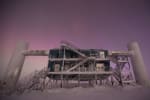Winter is long at the South Pole, at least when measured by the last plane out and the first plane back in. That’s roughly eight to nine months with no one (and no things) coming or going, quite a long period of isolation for the 40 or so winterovers at the station. You need a large store of provisions to cover the crew’s needs during that time. […]
News
Week 26 at the Pole
How to make any 4th of July celebration special? Start with a dish decorated in red, white and blue. […]
Week 25 at the Pole
Since bundling up to go outdoors is a bit of an ordeal, you don’t want to have to make unnecessary trips out to the ICL if you can avoid it. But there were a few of those unavoidable trips for the IceCube winterovers this past week. One was to replace a modem because of problems with an Iridium link. […]
Multimessenger search for cosmic sources by initial LIGO-Virgo and IceCube
In a joint analysis by the IceCube, LIGO and Virgo collaborations to be submitted to the journal Physical Review D, researchers aimed to identify GW events and high-energy neutrinos that could originate from the same astrophysical source and to determine their joint significance. No significant coincident events were found, but the search allowed researchers to derive upper limits on the rate of joint sources for a range of source emission parameters. […]
Week 24 at the Pole
Last week we mentioned that they were celebrating midwinter at the South Pole, but we didn’t really cover all the festivities. First, there was the traditional viewing of “The Shining,” Stanley Kubrick’s classic horror movie about an off-season caretaker in an isolated (also cold and white) location. […]
A search for dark matter in the galactic halo
The quest for galactic halo dark matter includes high-energy neutrino searches that might be produced by the self-annihilation of dark matter particles in our galaxy. If this is the case, IceCube should observe a characteristic anisotropy in the neutrino flux due to the additional dark-matter induced neutrinos. So far, the IceCube Collaboration has not found any significant deviation from the background expectation, following new results that have been submitted today to The European Physical Journal C. […]
Search for neutrino emission from extended and point-like astrophysical neutrino sources with IceCube
The IceCube Collaboration presents several searches for extended and point-like astrophysical neutrino sources using four years of data. No evidence of neutrino emission has been found yet, but a few models have been ruled out. This research has been submitted today to The Astrophysical Journal. […]
Week 23 at the Pole
Life at the Pole may be different than life elsewhere, but some things are the same just about everywhere. One of those things is celebrating holidays. Who knows? Maybe holidays are even more important when you live in small, isolated communities. Last week, at the South Pole and all over Antarctica, they were celebrating midwinter, a cultural event held in many places around the world in recognition of the winter solstice, an astronomical occurrence. […]
Week 22 at the Pole
This photograph of the ICL (IceCube Lab) almost looks as if it’s set against an artificial backdrop, but it is just the eerie effect of the sky lit by a rising moon. […]
An interview with the 2013-14 IceCube winterovers
Dag Larsen and Ian Rees arrived at the South Pole in November 2013. The brand-new winterovers had already been working for IceCube for a few weeks in Madison, learning all the ins and outs of their new job. Now they were ready to take over for Blaise Kuo Tiong and Felipe Pedreros, who had been at the Pole maintaining the detector for the previous 12 months. […]









